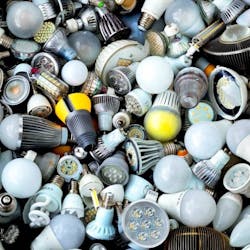After nearly a decade of mainstream use, LEDs are still only a fraction of the discards in Europe, so they appear to live up to longevity claims. Recycling them could be a different matter.
If the waste stream is any indication, then LED lamps would appear to be living up to manufacturers’ claims for longevity: In Europe they are still accounting for less than 2% of the discards.
Interested in articles & announcements on LED lamps and service programs?
That number comes from Eucolight, a group of organizations that oversee collection and recycling of lamps and lighting products across Europe. Between them, they claim to handle 79% of the lamps collected in the 18 countries in which they operate.
“LED lamps currently represent less than 2% of the waste stream, with their long life,” Eucolight reported after its annual conference, which took place last month in Sassenheim, the Netherlands.
The better part of a decade has passed since LEDs started entering the mainstream — long enough for them to turn up in much greater proportion than 2% if they were failing prematurely. Manufacturers informally bandy about claims of 20-year-and-longer lifetimes (although it is hard to find a warranty over 5 years, and many are shorter). Product labeling typically purports ranges of 15,000–30,000 hours, which at 3 hours a day translates loosely to between 14 and 28 years.
So while consumers still have not used enough LED lamps for long enough to outright prove the long-life claims, the waste stream provides solid circumstantial evidence that LED products are generally holding up pretty well so far. (Apologies to those of you who just binned one after 9 months; it can indeed happen.)
That’s the good news.
Most of the luminaires and lamps going into the recycling collections today are older light sources, not LED. (Photo credit: EucoLight member Recylum.)
But there’s a rub. LEDs will comprise about 30–40% of the waste within the next 10 years, and as that happens, the industry will have a bigger job to do in recycling them than what it has faced in the past with simpler designs, noted Nigel Harvey, CEO of UK lamp recycler and Eucolight member Recolight.
As LEDs Magazine reported in our recent circular economy feature story, whereas more than 90% of fluorescent tube material is recovered today in the UK, LED lamps construction will make it difficult to hit even 50%. (May/June issue content will hit the LEDs website soon but subscribers can view the article in full in the issue.)
“One of the benefits of LED technology is there’s been an explosion in the range of materials that are used, the designs that are used, the shapes, the sizes, everything,” Harvey told LEDs. “They allow for much more innovation in the way product is made. But that heterogeneity of product comes at a cost when it comes to recycling. You’ve got so many more materials in there. They are bonded together, often with glues and foams that make separation of them using mechanical processes very difficult. You’ve got all types of materials in there from plastics, glass, ceramics, aluminum, copper. You have PCBs. It’s a complete mixture. We have a problem that’s going to come back and bite us.”
Now, to get back to some good news: This pending challenge did not go unnoticed at the Eucolight conference.
“To this end, delegates learned about the technical composition and options for the future of LEDs and LED recycling techniques,” Eucolight reported.
We look forward to watching developments.
Need to know more about the circular economy?
On the Lux website, find additional insights from Nigel Harvey on embracing the circular economy.
Lux applications editor John Bullock also shed some light on the concept.
Even in the uncertain times posed by Brexit, industry organizations have espoused moving forward in a sustainable services model.
LightingEurope has explored the advantages of the circular economy in more detail.
MARK HALPERis a contributing editor for LEDs Magazine, and an energy, technology, and business journalist ([email protected]).
*Updated May 21, 2018 9:55 AM for photo correction provided by EucoLight organization member.

Mark Halper | Contributing Editor, LEDs Magazine, and Business/Energy/Technology Journalist
Mark Halper is a freelance business, technology, and science journalist who covers everything from media moguls to subatomic particles. Halper has written from locations around the world for TIME Magazine, Fortune, Forbes, the New York Times, the Financial Times, the Guardian, CBS, Wired, and many others. A US citizen living in Britain, he cut his journalism teeth cutting and pasting copy for an English-language daily newspaper in Mexico City. Halper has a BA in history from Cornell University.





![The DesignLights Consortium continues to make progress in shifting outdoor lighting products and implementation practices toward a more restrained and thoughtful strategy. [Image does not represent a DLC qualified fixture.] The DesignLights Consortium continues to make progress in shifting outdoor lighting products and implementation practices toward a more restrained and thoughtful strategy. [Image does not represent a DLC qualified fixture.]](https://img.ledsmagazine.com/files/base/ebm/leds/image/2024/08/66be810888ae93f656446f61-dreamstime_m_265700653.png?auto=format,compress&fit=&q=45&h=139&height=139&w=250&width=250)